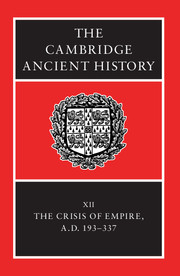Book contents
- Frontmatter
- PART I NARRATIVE
- PART II GOVERNMENT AND ADMINISTRATION
- PART III THE PROVINCES
- 8 Provinces and frontiers
- 9 Developments in provincial and local administration
- 10 Egypt from Septimius Severus to the death of Constantine
- PART IV THE ECONOMY OF THE EMPIRE
- PART V THE NON-ROMAN WORLD
- PART VI RELIGION, CULTURE AND SOCIETY
- Chronology
- Bibliography
- Index
- Topographical map of the Roman empire
- Map 2 The Roman empire in a.d. 211
- The Roman empire in a.d. 314
- The Rhine–Danube limes in the late second century
- References
10 - Egypt from Septimius Severus to the death of Constantine
from PART III - THE PROVINCES
Published online by Cambridge University Press: 28 March 2008
- Frontmatter
- PART I NARRATIVE
- PART II GOVERNMENT AND ADMINISTRATION
- PART III THE PROVINCES
- 8 Provinces and frontiers
- 9 Developments in provincial and local administration
- 10 Egypt from Septimius Severus to the death of Constantine
- PART IV THE ECONOMY OF THE EMPIRE
- PART V THE NON-ROMAN WORLD
- PART VI RELIGION, CULTURE AND SOCIETY
- Chronology
- Bibliography
- Index
- Topographical map of the Roman empire
- Map 2 The Roman empire in a.d. 211
- The Roman empire in a.d. 314
- The Rhine–Danube limes in the late second century
- References
Summary
PROLOGUE
The history of the Roman province of Egypt in the ‘high’ imperial period is treated in an earlier volume, an account which was intended to be generally valid for the first two centuries a.d. The present chapter continues and complements that account and is in turn complemented by a new treatment of Byzantine Egypt. One obvious anomaly requires explanation and justification: this chapter is not matched by corresponding chapters on the other provinces, as was the case in the earlier imperial volumes of the new edition. There are three main (and connected) reasons for privileging Egypt in this way. First, there is an exceptional amount of detailed documentary evidence for the province in the third and early fourth centuries, quite unmatched elsewhere. Second, important items of that evidence have often been generally taken, whether rightly or wrongly, as more broadly relevant to the ‘third century crisis’ of the empire in general and some have been central to interpretation of key aspects of that phenomenon. Third, there can be no doubt that the plentiful evidence for the period a.d. 284–337 is relevant and applicable to the empire at large in significant respects. Whatever might be thought of the ‘Sonderstellung’ of Egypt in the earlier period, it became more closely knitted into the structures of the eastern empire after 284 and lost some of its unique characteristics (such as the Alexandrian currency). Allowing for much idiosyncratic detail inherited from an earlier period, it is clear that the evidence for administration, taxation and the economy in Egypt after 284 significantly reflects or bears upon the character of changes which took place in the empire as a whole.
Keywords
- Type
- Chapter
- Information
- The Cambridge Ancient History , pp. 313 - 326Publisher: Cambridge University PressPrint publication year: 2005
References
- 19
- Cited by

